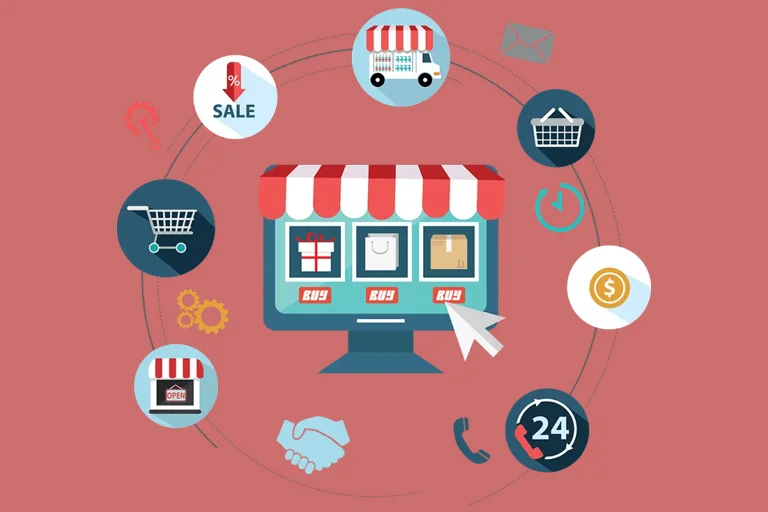Introduction
Before online stores became a thing, starting your own business seemed almost impossible for many. But now, thanks to ecommerce website platforms, anyone with determination can make their dream a reality. When you’re setting up an online store, it’s super important to think about the design of your website. Almost half of people decide whether to stay on a website just by looking at how it’s designed – the colors, fonts, images, words, and graphics all play a role in convincing customers to buy.
The best ecommerce website platforms are the ones that grab people’s attention, make shopping easy, and show off what makes the brand special. If you’re thinking about creating your own online store, keep reading. Our web design agency in Chicago is sharing the most important things to think about when you’re building your ecommerce website.
Choose your platform
An ecommerce website platforms is like an online tool that helps you create a store on the internet. There are a few popular ones:
1] WordPress / WooCommerce:
This is a common choice because it’s easy to use and flexible. WordPress is a widely used system, and WooCommerce is a free tool that adds a shopping cart to your WordPress website. It gives you lots of design options, and you can make your store unique.
2] Magento:
This tool is powerful and has a lot of options for customizing your store. But, it can be a bit tricky to use if you’re not familiar with web development.
3] Shopify:
This is a user-friendly platform where you can design your online store without needing much technical know-how. It provides tools and themes to make your store look good, and you can set it up pretty quickly. It’s a good choice for both beginners and experienced users.
These platforms make it easier for you to create your own online store without starting from scratch. They provide different features and levels of complexity, so you can choose the one that fits your needs.
Pages that impact the conversion rates
When you’re making an online store, there are eight important pages that really affect how many people buy things from your site. These pages are:
- Homepage: The main page of your store.
- About page: Where you tell people about your business.
- Category page: Where you organize your products into groups.
- Product page: The page for each thing you’re selling.
- Checkout page: Where people pay for their purchases.
- Subscription form: For people who want to get updates from your store regularly.
- Search results page: When customers look for something specific on your site.
Even though these pages have different jobs, they all need to be easy to use, load quickly, and connect with the people you want to sell to. Don’t try to put everything on the homepage. Instead, find the right balance between showing your products, giving details about them, and keeping your brand style consistent.
So, when you’re designing your online store, use the design elements wisely to make it easy for people to buy from you, and make your store stand out.
Designing with trust and security in mind
When you’re making an online store, it’s important to make customers feel safe and secure. People won’t buy from a website that doesn’t seem trustworthy. To build trust, you can:
1] Keep Transactions Safe:
Make sure buying things on your site is secure, and people’s personal info is protected.
2] Use Simple Language:
Write in a way that’s easy for everyone to understand. Avoid using complicated words or technical terms.
3] Show Your Business:
Share some basic info about your business. You can include general details, pictures of the people behind the business, and how to get in touch.
4] Contact Information:
Make sure people can easily find ways to contact you. This adds a layer of trust.
5] Connect on Social Media:
Link your social media accounts. It shows that your business is real and active.
6] FAQ Page:
Answer common questions on a Frequently Asked Questions (FAQ) page. This helps customers find information quickly.
7] Store Policies:
Make your store policies clear. Include details about shipping, returns, and how you handle customers’ info.
8] Privacy Policy:
Explain how you protect customers’ personal and financial information. This builds confidence in your online store.
By doing these things, you’re letting customers know that your online store is safe, reliable, and cares about their privacy.
9] Share product reviews
Customer reviews are super helpful for people who are thinking about buying something from your store. Reviews can answer questions, address concerns, and make the shopping experience better. You can make it even more useful by sharing info about the people who write the reviews.
To make things easier, use online tools that manage your business’s online reputation. These tools help you keep an eye on what people are saying about your products. Understanding what your customers like and don’t like is the first step in making your online store better in every way. It turns a good website into a really great one!
10] UI design
When you’re designing your online store, how it looks and feels is super important because it creates the first impression. It only takes about 50 milliseconds (that’s a tiny fraction of a second!) for someone to decide if they like a ecommerce website platforms or not. That quick impression really influences what they do next.
Since time is short, let’s quickly talk about organizing the first thing people see on your online store – the user interface. This is how your store looks and how customers interact with it. Making it appealing and easy to use is key to grabbing their attention and keeping them interested.
More information : 14 UI design tools and software for every step of the process
Prioritize branding
Think of your branding as the unique identity of your business – it’s like your business’s DNA. Take some time to really think about it. Your branding should show who you are as an online store, what you want to say, and what makes you different from others.
Branding is super important because it helps you connect with the people you want to sell to. So, when you’re designing your online store, make sure your branding is all over it. Choose colors that match your brand and make the style fit with the things you’re selling. Keep your brand consistent on social media, the website, and even on mobile apps.
If you’re not sure how it’s all going to look, you can use a website mockup design to plan it out. This way, your online store will have a consistent and unique style that represents your brand.
Product search
Simply put, if your customers can’t find a product, they won’t buy it. To help them find what they’re looking for, here’s what you can do:
1] Always Have a Search Box:
Put a search box on every page of your website. Make it really easy to see, and put it where people usually expect it, like the top right or center of the page.
2] Support Different Queries:
Your search should understand different types of questions, like product names, categories, details, and customer service info. This makes it easy for customers to explore your website.
3] Use Auto-Complete:
Make the search box suggest things as customers type. This not only helps them find what they want faster but can also suggest other things they might like.
4] Sorting and Filtering Options:
Give your customers choices! Let them quickly narrow down their search by getting rid of certain products or categories. Also, let them sort products based on different things like price, rating, newest items, or what’s selling the best.
By doing these things, you make it easy for your customers to find and buy the products they want on your online store.
Product page design
When you’re creating an online store, how you design the pages for each product is really important. Once people find a product they like on your website, you want to give them all the details they need, almost like they’re in a real store. Here’s how you can do that:
1]Lots of Pictures:
Write a lot about the product – what it’s like, what it does, and any other important info.Your goal is to make it feel like a real shopping experience, even though it’s online. So, use pictures and words to help your customers know everything about the product they’re interested in.
Product images
When people can’t touch the products in person, it’s your job to show them everything through pictures. Here’s how to make your product images great:
1] White Background:
Use a white background for your product photos. This helps your products stand out, and the background won’t clash with the colors of your products.
2] Big High-Quality Images:
Make your pictures large and super clear. Big images grab people’s attention, and high quality lets customers zoom in to see all the details.
3] Show from Different Angles:
Take pictures from lots of angles and close-ups. This helps customers see the product from different views, almost like they’re holding it. It’s the closest thing to a real shopping experience.
4] Include Videos:
Videos are a fun way to show off your products quickly. You can demonstrate how to use the product and share more details from a customer’s perspective.
5] Be Consistent:
Use the same style of images across your whole online store. This makes everything look neat and tidy. Keep the main product picture the same everywhere it appears. This way, your online shop looks clean, and customers have a smooth experience on your website.
Conclusion
To make your customers happy, it’s crucial to create a smooth online shopping experience. Designing an online store that really brings in sales is about more than just choosing colors and fonts – it’s about the entire journey. If you make the whole experience memorable, even people who are just browsing might become paying customers.
Remember, there’s no magic ecommerce website platforms that will instantly make all your business dreams come true. But by following our advice, we believe you can build a professional, good-looking, and easy-to-use online store that keeps customers coming back.
New opportunities for fast growth and a not-so-crowded online market mean that new players like you can compete with current industry leaders. To boost your chances of success, keep an eye on trends in online buying and selling. This helps you adjust to the always-changing world of online stores and gives you more ideas for your ecommerce website design.




